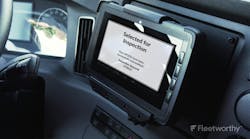Jeff Davis, vice president of safety for Napa River Insurance Services, has been on the insurance side of trucking since 1983, and a major red flag for him and other insurance providers is when there is a disconnect between a fleet’s safety and operations departments. From a Compliance, Safety, Accountability (CSA) standpoint, commercial fleets who have that disconnect will likely have much worse CSA scores and are more prone to risk.
When it comes to taking on new fleet clients to insure, Davis and his team look for the companies that have active driver managers or dispatchers who remind drivers about pre-trip inspections and problem areas on the road.
“When they’ve got a strong co-pilot there it works, and we see that [business] all the way through,” Davis explained during an Open Deck session on risk mitigation during the Truckload Carriers Association’s recent Virtual Safety and Security Conference. “When we have a situation where we are not feeling it with a company, we come back and we report that to our underwriters, and usually those are the companies we will take a pass on. But if it’s a situation where the company realizes they have some issues and they want to do something to fix that, we look for opportunities where it’s ripe for improvement.”
Often, Davis noted, a fleet’s safety department doesn’t get involved until there is a problem, and it is the operations department—usually the driver manager or the dispatcher—that deals with drivers every day. He emphasized the importance of involving operations in the overall safety process.
Jeff Hopkins, vice president of safety, training, and risk management at Boyd Bros. Transportation Inc., explained that in order to bridge the gap between the two departments safety needs to be addressed from a bigger picture, productivity perspective.
“When you are not in compliance with regulations, then you lose productivity,” he said. “If you can stay ahead of that and make sure you relate [both] operations’ priorities and needs, then you can improve both the operations metrics and the safety metrics.”
Milton Van Horn, certified director of safety for Carrier One Inc., explained that because operations staff is typically on the front line with drivers, they promote the fleet’s safety message. He also stressed the importance of thoroughly training and educating internal staff.
When Davis looks at potential new business partnerships, he said he considers a fleet’s ongoing education efforts and whether the fleet has realistic expectations for its drivers. He also said it is important that fleets know how regulations apply to them.
“What we really want to see is that education, which shows that value is placed on hard work and what their drivers put up with every day,” Davis said. “We find that the companies with empathetic staff that know what [drivers] are putting up with, and look to help them on a day-to-day basis are the successful carriers.”
Onboarding and continuing education
For Carrier One, the driver education process doesn’t stop at the end of orientation, it’s a continuous effort, explained Van Horn. The carrier also makes sure its safety department is on call 24/7 to assist drivers as needed.
“When drivers have inquiries, there is someone at the safety department that those drivers can reach day or night to help address their issues,” Van Horn said. “It could be a driving issue, a safety issue, or it could be an electronic logging device issue, whatever it may be, someone in the safety department will have the right answer for them. If they don’t have the right answer for them, they are going to get it by calling or texting someone in operations for assistance. The education process is an ongoing process from the day you hire that driver until the day that driver leaves.”
Hopkins explained that Boyd Bros. emphasizes onboarding drivers into the company culture.
“This is where we stress the safety culture to them,” he said. “We’ve implemented a 60-day review process so that for any of our drivers coming onboard, we bring them back in regardless of experience level at the 60-day mark. We conduct reviews, see if there are any questions, we do a review with operations staff to make sure that from a service perspective everything is going the way it should.”
From an insurance underwriting perspective, Davis said orientation is that most important part of indoctrinating drivers into a fleet’s culture.
“A lot of the folks coming through your orientation have already been through every video,” Davis noted. “I really hate orientations where you start every video with the same thing everyone has already seen, and they don’t come away with that feeling that they have made a good choice.”
“I really like the programs that introduce the drivers to the different people they are going to be working for and really give them a sense that they landed at a place they want to call home,” he added. “That is a lot more meaningful than the programs we have seen out there.”
Load securement training
Last year, the Federal Motor Carrier Safety Administration (FMCSA) cited 17,969 violations for no or improper load securement. Of those violations, FMCSA put 91.2%, or 16,389 carriers, out of service.
Load securement can be especially risky for drivers who are jumping on and off trailers multiple times to fasten loads. Besides the potential risks for injury, if flatbed cargo isn’t secured properly, the load is at risk of being damaged or lost during the transportation process.
Carrier One has several trailers staged in its yard and operations and safety managers walk drivers through step by step on how to secure those loads correctly, explained Van Horn.
“I watched drivers jump up and down off that trailer, so to speak, a dozen times, when they could stage all their equipment in advance and get up and down only once or twice—reducing the risk of falling off the trailer and injuring themselves,” Van Horn pointed out. “Teach them the proper way to stage all their securement equipment so they have the least number of events getting on and off that trailer. Once they get a system in place, they can secure it much quicker and they are not wearing themselves out before trying to drive for hours afterwards.”
When Boyd Bros. hires drivers with flatbed experience, the carrier offers a refresher on how it secures loads. Drivers are then given a written test and put through a hands-on evaluation to demonstrate their skills.
“We have a four-day class where we go in depth and talk about the techniques used, then we go outside and demonstrate with the class hands on, and then at the end of that period, they do a hands-on test. If they pass that, they are good to go,” explained Hopkins.
These types of training exercises are designed to give fleet managers the opportunity to see how drivers will function in real-world environments ahead of time.
“There are a lot of folks out there who think they can do open-deck, flatbed work, but once they get into it, they can’t cut it,” explained Davis. “It’s much more valuable to find that out in your yard than wait two trips into it and find out that you have somebody out there who is going to damage your freight or lose a piece of freight.”
From the insurance side of it, Davis said when insurers defend a claim in which cargo securement becomes an issue, they are often questioned as to what kind of training the driver had. And the fleets that don’t properly train their drivers will end up paying out much more in the long run.




